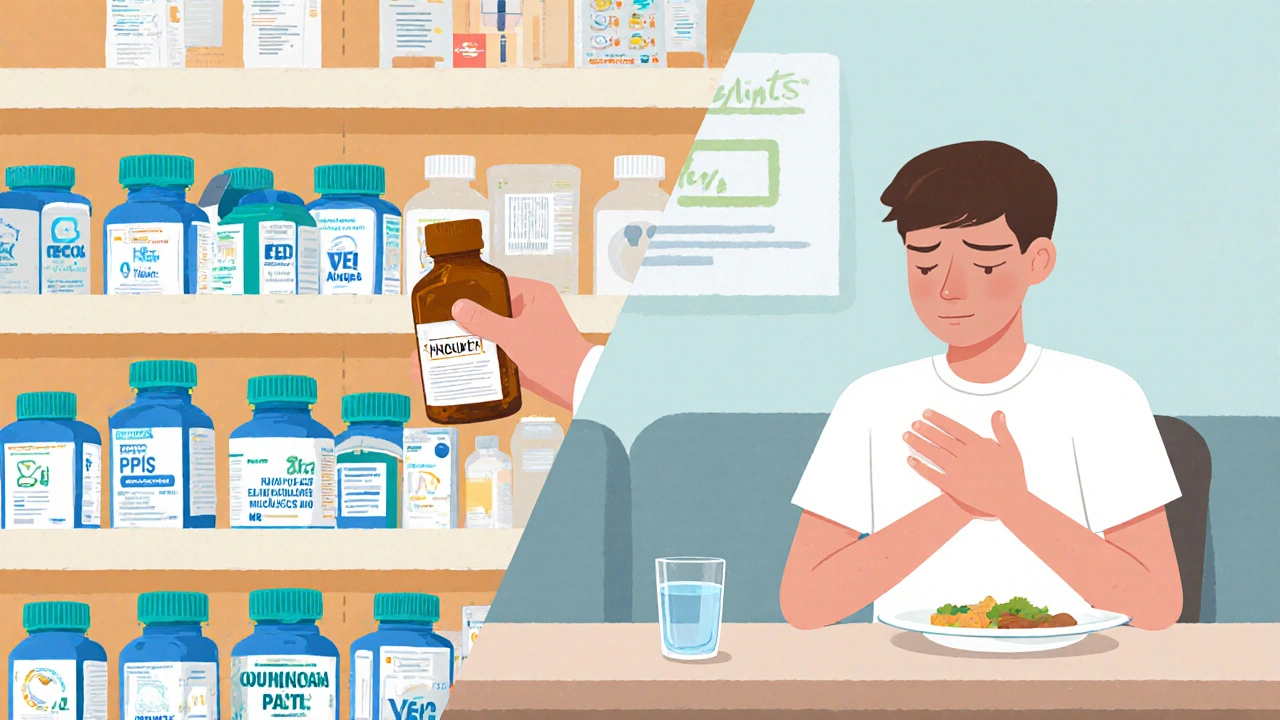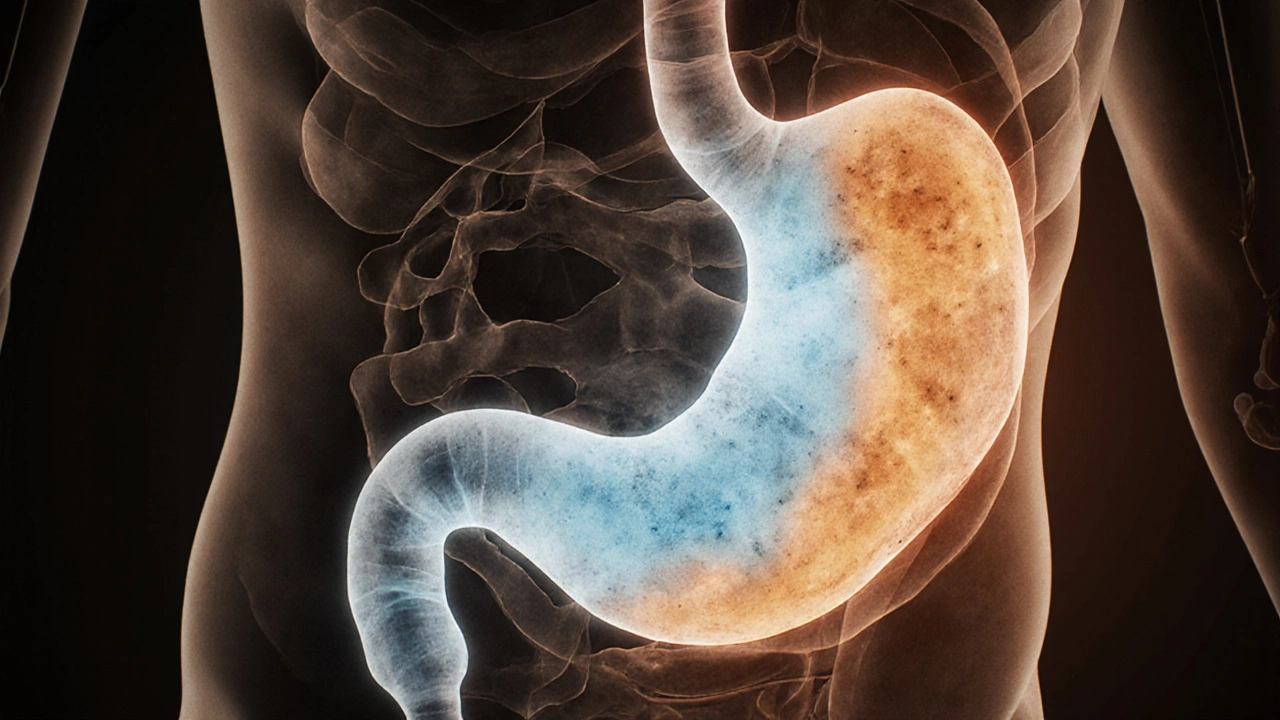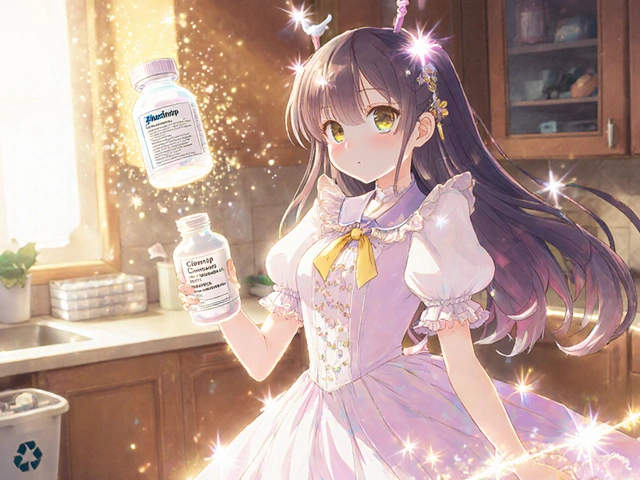Acid Reducer Selector
Select your symptoms and medications to get a recommendation:
Key Takeaways
- Pepcid (famotidine) is an H2‑blocker that works fast, costs less, and has fewer drug interactions than most PPIs.
- Ranitidine and cimetidine are older H2‑blockers; they’re cheaper but can cause more side effects or have supply issues.
- Omeprazole, pantoprazole and esomeprazole are proton‑pump inhibitors (PPIs) that provide longer relief for severe GERD but are slower to act and may raise infection risk.
- Choosing the right acid reducer depends on symptom severity, onset speed needed, dosing convenience, and any other medicines you take.
- For most mild‑to‑moderate heartburn, Pepcid strikes the best balance of efficacy, safety, and price.
What is Pepcid (Famotidine)?
Famotidine - marketed as Pepcid - belongs to the H2‑blocker class of acid‑reducing drugs. It blocks histamineH2 receptors on the stomach’s parietal cells, cutting the amount of acid they pump out.
Typical adult dosing is 20mg once or twice daily for heartburn, or 40mg once daily for ulcer prevention. Effects start within 30‑60minutes and last up to 12hours, making it a solid choice for on‑the‑go relief.
Famotidine is available over‑the‑counter in NewZealand for lower strengths (10mg, 20mg) and by prescription for higher doses (40mg, 80mg). Because it’s not metabolised heavily by the liver, it has fewer interactions than many other acid reducers.
When Do People Usually Take Pepcid?
- Occasional heartburn or indigestion after a big meal.
- Erosive esophagitis or mild gastric ulcer where a short‑term acid blocker is enough.
- Pre‑operative preparation to reduce gastric acidity.
- As part of a combination regimen when a PPI alone isn’t sufficient.
If you have severe, persistent GERD symptoms that wake you at night, a PPI may be needed instead. But for most everyday flare‑ups, Pepcid offers a quicker, cheaper answer.
Other Acid‑Reducer Options
Before we dive into a side‑by‑side comparison, let’s meet the main alternatives you’ll see on pharmacy shelves.
Ranitidine (Zantac) - another H2‑blocker that was widely used until 2020 when many batches were recalled over NDMA impurities. Some manufacturers have re‑introduced purified versions, but availability varies.
Cimetidine (Tagamet) - the oldest H2‑blocker. It’s cheap but can interfere with the metabolism of several drugs, especially those processed by CYP450 enzymes.
Nizatidine (Axid) - less common, but offers a potency similar to famotidine with a slightly longer half‑life.
On the PPI side, the most popular choices are:
- Omeprazole - the first‑generation PPI, available OTC in 20mg capsules.
- Pantoprazole - prescription‑only in NewZealand, often chosen for its lower drug‑interaction profile.
- Esomeprazole - marketed as Nexium, a slightly more potent PPI that works well for severe GERD.

Quick‑Reference Comparison Table
| Drug | Class | Typical Adult Dose | Onset of Relief | Duration of Action | Common Side Effects | Approx. NZD Cost (28days) |
|---|---|---|---|---|---|---|
| Famotidine (Pepcid) | H2‑blocker | 20‑40mg once or twice daily | 30‑60min | 8‑12hrs | Headache, dizziness, constipation | $6‑$12 |
| Ranitidine | H2‑blocker | 150mg twice daily | 45‑90min | 8‑12hrs | Rare liver enzyme elevations | $4‑$8 |
| Cimetidine | H2‑blocker | 200‑400mg twice daily | 60‑90min | 8‑12hrs | Gynecomastia, hormone‑related effects | $3‑$7 |
| Nizatidine | H2‑blocker | 150mg twice daily | 30‑45min | 10‑12hrs | Diarrhea, headache | $9‑$14 |
| Omeprazole | PPI | 20mg once daily | 1‑4hrs | 24+hrs | Headache, abdominal pain | $8‑$15 |
| Pantoprazole | PPI | 40mg once daily | 1‑4hrs | 24+hrs | Diarrhea, nausea | $12‑$20 |
| Esomeprazole | PPI | 20‑40mg once daily | 1‑4hrs | 24+hrs | Flatulence, abdominal discomfort | $15‑$25 |
How to Choose the Right Acid Reducer for You
Think about three practical factors before you reach for a bottle.
- Symptom urgency. If you need relief within an hour, an H2‑blocker like Pepcid or nizatidine wins. PPIs take a few hours to reach full effect.
- Frequency of use. Occasional heartburn (once‑twice a week) pairs well with an over‑the‑counter H2‑blocker. Chronic GERD that needs nightly dosing leans toward a PPI.
- Medication safety. Review your current prescriptions. If you’re on warfarin, certain antivirals, or anti‑seizure meds, avoid cimetidine because it can raise their levels. Pepcid has a clean interaction profile.
Budget matters too. In NewZealand, famotidine generics cost about half of most PPIs, so for people on a tight budget, Pepcid is a sensible first step.
Safety, Interactions, and Special Populations
All acid reducers are generally safe when taken as directed, but a few cautions are worth noting.
- Kidney function. Famotidine is cleared renally; dose‑adjust if eGFR<30mL/min. PPIs don’t need renal adjustment.
- Pregnancy. Both H2‑blockers and PPIs are Category B in NZ, but always check with your obstetrician.
- Long‑term use. Chronic PPI therapy (>1year) has been linked to vitaminB12 deficiency, magnesium loss, and increased fracture risk. H2‑blockers have a milder profile, though tolerance can develop.
For seniors, the lower interaction risk of famotidine makes it a safer everyday option, especially if they’re juggling multiple prescriptions.
Real‑World Scenarios
Scenario1 - Weekend BBQ: You eat a greasy burger and feel a burning sensation 30minutes later. You reach for a 20mg Pepcid tablet. Within an hour the pain eases, and you enjoy the rest of the evening.
Scenario2 - Nightly Acid Reflux: Your throat is sore every morning, and OTC H2‑blockers haven’t helped. Your GP prescribes omeprazole 20mg before breakfast for 8weeks. After two weeks, the morning symptoms disappear.
Scenario3 - Polypharmacy: You take warfarin, atorvastatin, and metformin. Your doctor avoids cimetidine because it can raise warfarin levels, and instead recommends famotidine, which won’t interfere with your blood thinner.
Bottom Line
If you need quick, affordable relief for mild‑to‑moderate heartburn, Pepcid (famotidine) is the sweet spot between speed, safety, and cost. Reserve PPIs for more severe, persistent cases or when you need around‑the‑clock acid suppression. Always talk to a pharmacist or doctor if you’re unsure which option matches your health profile.

Frequently Asked Questions
Can I take Pepcid and a PPI together?
Yes, some doctors combine an H2‑blocker with a PPI to cover both immediate and long‑term relief. Typically you’d take Pepcid 30minutes before a meal and the PPI once daily in the morning. Always check with your prescriber, especially if you have kidney issues.
Is famotidine safe for children?
Famotidine is approved for pediatric use at lower doses (e.g., 0.25mg/kg). It’s commonly used for infant reflux under medical supervision. Do not give adult doses to kids without a doctor’s order.
Why did some countries recall ranitidine?
Ranitidine was found to contain N‑nitrosodimethylamine (NDMA), a probable carcinogen, at levels exceeding safety limits. This prompted recalls worldwide in 2020. New manufacturing processes have reduced NDMA, but many pharmacies still prefer other H2‑blockers.
Can long‑term PPI use affect bone health?
Studies suggest PPIs can lower calcium absorption, modestly increasing fracture risk, especially in older adults. If you need a PPI for more than a year, discuss calcium and vitaminD supplementation with your doctor.
Do H2‑blockers cause tolerance?
Yes, with daily use the body can adapt, making the drug less effective over time. That’s why doctors often recommend using H2‑blockers only for short courses or symptom‑as‑needed basis.






Comments
Timothy Javins
September 28, 2025 AT 03:59 AMIf you’re looking for the most consistent acid suppression, a PPI like omeprazole still wins the marathon, even if it takes a few hours to kick in.
Kay Yang
September 28, 2025 AT 20:39 PMNice rundown of options :) especially helpful for folks trying to balance speed and cost.
Rajesh Kumar Batham
September 29, 2025 AT 13:19 PM👍 Pepcid’s quick onset is perfect for that post‑BBQ burn, but if you’re on warfarin, sticking with famotidine is the safest play. 💊
Bill Gallagher
September 30, 2025 AT 05:59 AMWhen you examine the pharmacokinetic profile, you notice that famotidine reaches peak plasma concentration within thirty to sixty minutes, which, compared to the delayed onset of proton‑pump inhibitors that often require several days to achieve maximal effect, makes it an attractive first‑line agent for episodic heartburn; however, one must also weigh the duration of action, as H2‑blockers typically provide relief for eight to twelve hours, whereas PPIs maintain gastric pH elevation for a full twenty‑four‑hour cycle, thereby reducing nocturnal symptoms in chronic gastro‑esophageal reflux disease; moreover, the cost‑effectiveness analysis reveals that generic famotidine tablets are priced markedly lower than most branded PPIs, an essential consideration for patients without comprehensive insurance coverage, yet the interaction profile cannot be overlooked, since cimetidine is notorious for CYP450 inhibition, potentially elevating plasma levels of concomitant medications, whereas famotidine exhibits minimal hepatic metabolism, preserving the therapeutic window of drugs such as warfarin and certain antivirals; additionally, the safety data indicate a lower incidence of long‑term complications, for instance, the association of chronic PPI use with increased risk of osteoporosis‑related fractures and enteric infections, a concern that is less pronounced with H2‑blockers; consequently, clinicians often adopt a step‑ladder approach, initiating therapy with a fast‑acting H2‑blocker for acute episodes and escalating to a PPI if symptoms persist or become refractory, a strategy that optimizes both patient outcomes and healthcare expenditures, and finally, patient education remains paramount-informing individuals about proper dosing intervals, potential side effects such as headache or constipation, and the importance of adherence to avoid tachyphylaxis, which can diminish the efficacy of H2‑blockers over time.
Rajashree Varma
September 30, 2025 AT 22:39 PMFor most mild heartburn, a 20 mg dose of famotidine offers a quick fix, is easy on the wallet, and rarely clashes with other meds.
Anshuman Pandey
October 1, 2025 AT 15:19 PMThink of your stomach as a fire that needs careful tending; famotidine is the water that douses the flames fast, while PPIs are the fire‑break that prevents future sparks.
Thomas Malloy
October 2, 2025 AT 07:59 AMQuick fix, Pepcid does the job.
Sushma Gowda
October 3, 2025 AT 00:39 AMRemember, the best choice fits your lifestyle – if you only need occasional relief, grab an OTC famotidine; if nights are rough, talk to your doctor about stepping up to a PPI.
Angie Wallace
October 3, 2025 AT 17:19 PMFamotidine works well and doesn’t cost much
Doris Montgomery
October 4, 2025 AT 09:59 AMHonestly, the article feels like a sales pitch for Pepcid; it downplays the real benefits of PPIs for severe GERD.
Nick Gulliver
October 5, 2025 AT 02:39 AMIn America we’ve got the freedom to pick any drug, but cheap famotidine still beats overpriced PPIs that insurers push.
Sadie Viner
October 5, 2025 AT 19:19 PMFor patients seeking an evidence‑based approach, consider the following: first, assess symptom severity; second, evaluate drug‑interaction risk; third, align treatment with cost considerations. By adhering to this structured methodology, clinicians can ensure optimal therapeutic outcomes while minimizing adverse events.
Kristen Moss
October 6, 2025 AT 11:59 AMYo, famotidine’s cheap as hell, why chase pricey PPIs when you can just grab a Pepcid at the store?
Rachael Tanner
October 7, 2025 AT 04:39 AMWhile Pepcid pirouettes gracefully through the gastric milieu, its modest stature belies a robust efficacy that rivals the more ostentatious PPIs, especially when budgetary constraints loom large.